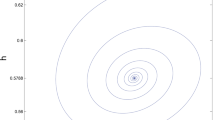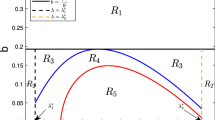Abstract
In this paper, by approximating the non-local spatial dispersal equation by an associated reaction–diffusion system, an activator–inhibitor model with non-local dispersal is transformed into a reaction–diffusion system coupled with one ordinary differential equation. We prove that, to some extent, the non-locality-induced instability of the non-local system can be regarded as diffusion-driven instability of the reaction–diffusion system for sufficiently small perturbation. We study the structure of the spectrum of the corresponding linearized operator, and we use linear stability analysis and steady-state bifurcations to show the existence of non-constant steady states which generates non-homogeneous spatial patterns. As an example of our results, we study the bifurcation and pattern formation of a modified Klausmeier–Gray–Scott model of water–plant interaction.






Similar content being viewed by others
References
Alfaro M, Izuhara H, Mimura M (2018) On a nonlocal system for vegetation in drylands. J Math Biol 77(6–7):1761–1793
Bai X-L, Li F (2018) Classification of global dynamics of competition models with nonlocal dispersals I: symmetric kernels. Calc Var Partial Differ Equ 57(6):1–35
Bellomo N, Bellouquid A, Tao Y, Winkler M (2015) Toward a mathematical theory of Keller-Segel models of pattern formation in biological tissues. Math Models Methods Appl Sci 25(9):1663–1763
Chen S, Shi J, Zhang G (2021) Spatial pattern formation in activator-inhibitor models with nonlocal dispersal. Discrete Contin Dyn Syst Ser B 26(4):1843–1866
Chen SS, Shi JP (2012) Stability and Hopf bifurcation in a diffusive logistic population model with nonlocal delay effect. J Differ Equ 253(12):3440–3470
Chen SS, Yu JS (2018) Stability and bifurcation on predator-prey systems with nonlocal prey competition. Discrete Contin Dyn Syst 38(1):43–62
Crandall M, Rabinowitz P (1971) Bifurcation from simple eigenvalues. J Funct Anal 8(2):321–340
Ei S-I, Ishii H (2021) The motion of weakly interacting localized patterns for reaction-diffusion systems with nonlocal effect. Discrete Contin Dyn Syst Ser B 26(1):173–190
Eigentler L, Sherratt J (2018) Analysis of a model for banded vegetation patterns in semi-arid environments with nonlocal dispersal. J Math Biol 77(3):739–763
Fu X, Griette Q, Magal P (2020) A cell-cell repulsion model on a hyperbolic Keller-Segel equation. J Math Biol 80(7):2257–2300
Fuentes MA, Kuperman MN, Kenkre VM (2003) Nonlocal interaction effects on pattern formation in population dynamics. Phys Rev Lett 91(15):158104
Furter J, Grinfeld M (1989) Local vs. nonlocal interactions in population dynamics. J Math Biol 27(1):65–80
Gourley SA, Chaplain MAJ, Davidson FA (2001) Spatio-temporal pattern formation in a nonlocal reaction-diffusion equation. Dyn Syst 16(2):173–192
Gray P, Scott S (1985) Sustained oscillations and other exotic patterns of behavior in isothermal reactions. J Phys Chem 89(1):22–32
Horstmann D (2003) From 1970 until present: the Keller-Segel model in chemotaxis and its consequences. I. Jahresber. Deutsch Math -Verein 105(3):103–165
Hutson V, Martinez S, Mischaikow K, Vickers GT (2003) The evolution of dispersal. J Math Biol 47(6):483–517
Keller EF, Segel LA (1971) Model for chemotaxis. J Theoret Biol 30(2):225–234
Klausmeier C (1999) Regular and irregular patterns in semiarid vegetation. Science 284(5421):1826–1828
Kondo S, Miura T (2010) Reaction-diffusion model as a framework for understanding biological pattern formation. Science 329(5999):1616–1620
Kot M, Lewis MA, van den Driessche P (1996) Dispersal data and the spread of invading organisms. Ecology 77(7):2017–2042
Li F, Lou Y, Wang Y (2014) Global dynamics of a competition model with non-local dispersal I: the shadow system. J Math Anal Appl 412(1):485–497
Li Y, Marciniak-Czochra A, Takagi I, Wu B (2017) Bifurcation analysis of a diffusion-ODE model with Turing instability and hysteresis. Hiroshima Math J 47(2):217–247
Lou Y, Ni WM (1996) Diffusion, self-diffusion and cross-diffusion. J Differ Equ 131(1):79–131
Marciniak-Czochra A, Härting S, Karch G, Suzuki K (2018) Dynamical spike solutions in a nonlocal model of pattern formation. Nonlinearity 31(5):1757–1781
Marciniak-Czochra A, Karch G, Suzuki K (2017) Instability of Turing patterns in reaction-diffusion-ODE systems. J Math Biol 74(3):583–618
Meinhardt H (1992) Pattern formation in biology: a comparison of models and experiments. Rep Prog Phys 55(6):797
Mimura M, Kawasaki K (1980) Spatial segregation in competitive interaction-diffusion equations. J Math Biol 9(1):49–64
Mimura M, Nishiura Y, Tesei A, Tsujikawa T (1984) Coexistence problem for two competing species models with density-dependent diffusion. Hiroshima Math J 14(2):425–449
Ni WM (1998) Diffusion, cross-diffusion, and their spike-layer steady states. Notices Amer Math Soc 45(1):9–18
Ninomiya H, Tanaka Y, Yamamoto H (2017) Reaction, diffusion and non-local interaction. J Math Biol 75(5):1203–1233
Pearson J (1993) Complex patterns in a simple system. Science 261(5118):189–192
Pueyo Y, Kéfi S, Alados C, Rietkerk M (2008) Dispersal strategies and spatial organization of vegetation in arid ecosystems. Oikos 117(10):1522–1532
Rietkerk M, Dekker S, De Ruiter P, van de Koppel J (2004) Self-organized patchiness and catastrophic shifts in ecosystems. Science 305(5692):1926–1929
Sheth R, Marcon L, Bastida MF, Junco M, Quintana L, Dahn R, Kmita M, Sharpe J, Ros MA (2012) Hox genes regulate digit patterning by controlling the wavelength of a Turing-type mechanism. Science 338(6113):1476–1480
Shi J, Wang C, Wang H (2019) Diffusive spatial movement with memory and maturation delays. Nonlinearity 32(9):3188–3208
Shi J, Wang C, Wang H (2021) Spatial movement with diffusion and memory-based self-diffusion and cross-diffusion. J Differ Equ 305:242–269
Shi J, Wang C, Wang H, Yan X (2020) Diffusive spatial movement with memory. J Dynam Differ Equ 32(2):979–1002
Shi Q, Shi J, Song Y (2022) Effect of spatial average on the spatiotemporal pattern formation of reaction-diffusion systems. J Dynam Differ Equ 34(3):2123–2156
Shi Q, Shi J, and Wang H (2021) Spatial movement with distributed memory. J. Math. Biol., 82(4):Paper No. 33, 32
Sick S, Reinker S, Timmer J, Schlake T (2006) WNT and DKK determine hair follicle spacing through a reaction-diffusion mechanism. Science 314(5804):1447–1450
Tian C, Shi Q, Cui X, Guo J, Yang Z, Shi J (2019) Spatiotemporal dynamics of a reaction-diffusion model of pollen tube tip growth. J Math Biol 79(4):1319–1355
Turing AM (1952) The chemical basis of morphogenesis Philos. Trans Roy Soc London Ser B 237(641):37–72
Wang X, Shi J, Zhang G (2021) Bifurcation and pattern formation in diffusive Klausmeier-Gray-Scott model of water-plant interaction. J Math Anal Appl 497(1):124860
Wang X, Zhang G (2021) Bifurcation analysis of a general activator-inhibitor model with nonlocal dispersal. Discrete Contin Dyn Syst Ser B 26(8):4459–4477
Yang F-Y, Li W-T, Ruan S (2019) Dynamics of a nonlocal dispersal SIS epidemic model with Neumann boundary conditions. J. Differential Equations 267(3):2011–2051
Yi FQ, Wei JJ, Shi JP (2009) Bifurcation and spatiotemporal patterns in a homogeneous diffusive predator-prey system. J Differ Equ 246(5):1944-1977
Zaytseva S, Shi J, Shaw LB (2020) Model of pattern formation in marsh ecosystems with nonlocal interactions. J Math Biol 80(3):655–686
Acknowledgements
This work was done when the first author visited Department of Mathematics, William & Mary during the academic year 2018-2019, and she would like to thank Department of Mathematics, William & Mary for their support and warm hospitality.
Author information
Authors and Affiliations
Corresponding author
Additional information
In Memory of Professor Masayasu Mimura.
Publisher's Note
Springer Nature remains neutral with regard to jurisdictional claims in published maps and institutional affiliations.
Partially supported by Grants from National Science Foundation of China (11701472, 11871403, 11871060), China Scholarship Council and US-NSF Grant DMS-1853598, Fundamental Research Funds for the Central Universities (XDJK2020B050)
Rights and permissions
Springer Nature or its licensor (e.g. a society or other partner) holds exclusive rights to this article under a publishing agreement with the author(s) or other rightsholder(s); author self-archiving of the accepted manuscript version of this article is solely governed by the terms of such publishing agreement and applicable law.
About this article
Cite this article
Wang, X., Shi, J. & Zhang, G. Bifurcation and Pattern Formation in an Activator–Inhibitor Model with Non-local Dispersal. Bull Math Biol 84, 140 (2022). https://doi.org/10.1007/s11538-022-01098-0
Received:
Accepted:
Published:
DOI: https://doi.org/10.1007/s11538-022-01098-0
Keywords
- Non-local dispersal
- Water–plant model
- Reaction–diffusion-ODE system
- Pattern formation
- Spectrum
- Bifurcation




